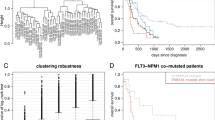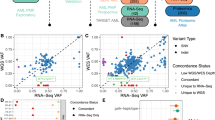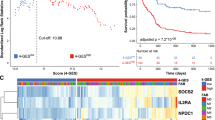Abstract
As a highly heterogeneous disease, acute myeloid leukemia (AML) needs fine risk stratification to get an optimal outcome of patients. MicroRNAs have florid biological functions and have critical roles in the pathogenesis and prognosis in AML. Expression levels of some single microRNAs are influential for prognosis, but a system integrating several together and considering the weight of each should be more powerful. We thus analyzed the clinical, genetic and microRNA profiling data of 138 de novo AML patients of our institute. By multivariate analysis, we identified that high expression of hsa-miR-9-5p and hsa-miR-155-5p were independent poor prognostic factors, whereas that of hsa-miR-203 had a trend to be a favorable factor. We constructed a scoring system from expression of these three microRNAs by considering the weight of each. The scores correlated with distinct clinical and biological features and outperformed single microRNA expression in prognostication. In both ours and another validation cohort, higher scores were associated with shorter overall survival, independent of other well-known prognostic factors. By analyzing the mRNA expression profiles, we sorted out several cancer-related pathways highly correlated with the microRNA prognostic signature. We conclude that this 3-microRNA scoring system is simple and powerful for risk stratification of de novo AML patients.
This is a preview of subscription content, access via your institution
Access options
Subscribe to this journal
Receive 12 print issues and online access
$259.00 per year
only $21.58 per issue
Buy this article
- Purchase on Springer Link
- Instant access to full article PDF
Prices may be subject to local taxes which are calculated during checkout




Similar content being viewed by others
References
Ambros V . The functions of animal microRNAs. Nature 2004; 431: 350–355.
Bartel DP . MicroRNAs: target recognition and regulatory functions. Cell 2009; 136: 215–233.
Marcucci G, Mrozek K, Radmacher MD, Garzon R, Bloomfield CD . The prognostic and functional role of microRNAs in acute myeloid leukemia. Blood 2011; 117: 1121–1129.
Marcucci G, Radmacher MD, Maharry K, Mrozek K, Ruppert AS, Paschka P et al. MicroRNA expression in cytogenetically normal acute myeloid leukemia. N Engl J Med 2008; 358: 1919–1928.
Garzon R, Volinia S, Liu CG, Fernandez-Cymering C, Palumbo T, Pichiorri F et al. MicroRNA signatures associated with cytogenetics and prognosis in acute myeloid leukemia. Blood 2008; 111: 3183–3189.
Li Z, Lu J, Sun M, Mi S, Zhang H, Luo RT et al. Distinct microRNA expression profiles in acute myeloid leukemia with common translocations. Proc Natl Acad Sci USA 2008; 105: 15535–15540.
Popovic R, Riesbeck LE, Velu CS, Chaubey A, Zhang J, Achille NJ et al. Regulation of mir-196b by MLL and its overexpression by MLL fusions contributes to immortalization. Blood 2009; 113: 3314–3322.
Becker H, Marcucci G, Maharry K, Radmacher MD, Mrozek K, Margeson D et al. Favorable prognostic impact of NPM1 mutations in older patients with cytogenetically normal de novo acute myeloid leukemia and associated gene- and microRNA-expression signatures: a Cancer and Leukemia Group B study. J Clin Oncol 2010; 28: 596–604.
Garzon R, Garofalo M, Martelli MP, Briesewitz R, Wang L, Fernandez-Cymering C et al. Distinctive microRNA signature of acute myeloid leukemia bearing cytoplasmic mutated nucleophosmin. Proc Natl Acad Sci USA 2008; 105: 3945–3950.
Jongen-Lavrencic M, Sun SM, Dijkstra MK, Valk PJ, Lowenberg B . MicroRNA expression profiling in relation to the genetic heterogeneity of acute myeloid leukemia. Blood 2008; 111: 5078–5085.
Schwind S, Maharry K, Radmacher MD, Mrozek K, Holland KB, Margeson D et al. Prognostic significance of expression of a single microRNA, miR-181a, in cytogenetically normal acute myeloid leukemia: a Cancer and Leukemia Group B study. J Clin Oncol 2010; 28: 5257–5264.
Sun SM, Rockova V, Bullinger L, Dijkstra MK, Dohner H, Lowenberg B et al. The prognostic relevance of miR-212 expression with survival in cytogenetically and molecularly heterogeneous AML. Leukemia 2013; 27: 100–106.
Xiong Y, Li Z, Ji M, Tan AC, Bemis J, Tse JV et al. MIR29B regulates expression of MLLT11 (AF1Q), an MLL fusion partner, and low MIR29B expression associates with adverse cytogenetics and poor overall survival in AML. Br J Haematol 2011; 153: 753–757.
Zhu C, Wang Y, Kuai W, Sun X, Chen H, Hong Z . Prognostic value of miR-29a expression in pediatric acute myeloid leukemia. Clin Biochem 2013; 46: 49–53.
Zhu YD, Wang L, Sun C, Fan L, Zhu DX, Fang C et al. Distinctive microRNA signature is associated with the diagnosis and prognosis of acute leukemia. Med Oncol 2012; 29: 2323–2331.
Marcucci G, Maharry KS, Metzeler KH, Volinia S, Wu YZ, Mrozek K et al. Clinical role of microRNAs in cytogenetically normal acute myeloid leukemia: miR-155 upregulation independently identifies high-risk patients. J Clin Oncol 2013; 31: 2086–2093.
Chou WC, Chou SC, Liu CY, Chen CY, Hou HA, Kuo YY et al. TET2 mutation is an unfavorable prognostic factor in acute myeloid leukemia patients with intermediate-risk cytogenetics. Blood 2011; 118: 3803–3810.
The Cancer Genome Atlas Research Network. Genomic and epigenomic landscapes of adult de novo acute myeloid leukemia. N Engl J Med 2013; 368: 2059–2074.
Falini B, Mecucci C, Tiacci E, Alcalay M, Rosati R, Pasqualucci L et al. Cytoplasmic nucleophosmin in acute myelogenous leukemia with a normal karyotype. N Engl J Med 2005; 352: 254–266.
Chou WC, Hou HA, Liu CY, Chen CY, Lin LI, Huang YN et al. Sensitive measurement of quantity dynamics of FLT3 internal tandem duplication at early time points provides prognostic information. Ann Oncol 2011; 22: 696–704.
Bacher U, Haferlach C, Kern W, Haferlach T, Schnittger S . Prognostic relevance of FLT3-TKD mutations in AML: the combination matters—an analysis of 3082 patients. Blood 2008; 111: 2527–2537.
Hou HA, Kuo YY, Liu CY, Chou WC, Lee MC, Chen CY et al. DNMT3A mutations in acute myeloid leukemia: stability during disease evolution and clinical implications. Blood 2012; 119: 559–568.
Kramer A, Green J, Pollard J Jr, Tugendreich S . Causal analysis approaches in Ingenuity Pathway Analysis. Bioinformatics 2014; 30: 523–530.
Baldus CD, Tanner SM, Ruppert AS, Whitman SP, Archer KJ, Marcucci G et al. BAALC expression predicts clinical outcome of de novo acute myeloid leukemia patients with normal cytogenetics: a Cancer and Leukemia Group B Study. Blood 2003; 102: 1613–1618.
Marcucci G, Baldus CD, Ruppert AS, Radmacher MD, Mrozek K, Whitman SP et al. Overexpression of the ETS-related gene, ERG, predicts a worse outcome in acute myeloid leukemia with normal karyotype: a Cancer and Leukemia Group B study. J Clin Oncol 2005; 23: 9234–9242.
Marcucci G, Maharry K, Whitman SP, Vukosavljevic T, Paschka P, Langer C et al. High expression levels of the ETS-related gene, ERG, predict adverse outcome and improve molecular risk-based classification of cytogenetically normal acute myeloid leukemia: a Cancer and Leukemia Group B Study. J Clin Oncol 2007; 25: 3337–3343.
Heuser M, Beutel G, Krauter J, Dohner K, von Neuhoff N, Schlegelberger B et al. High meningioma 1 (MN1) expression as a predictor for poor outcome in acute myeloid leukemia with normal cytogenetics. Blood 2006; 108: 3898–3905.
Bullinger L, Dohner K, Bair E, Frohling S, Schlenk RF, Tibshirani R et al. Use of gene-expression profiling to identify prognostic subclasses in adult acute myeloid leukemia. N Engl J Med 2004; 350: 1605–1616.
Kroon E, Krosl J, Thorsteinsdottir U, Baban S, Buchberg AM, Sauvageau G . Hoxa9 transforms primary bone marrow cells through specific collaboration with Meis1a but not Pbx1b. EMBO J 1998; 17: 3714–3725.
Sauvageau G, Thorsteinsdottir U, Eaves CJ, Lawrence HJ, Largman C, Lansdorp PM et al. Overexpression of HOXB4 in hematopoietic cells causes the selective expansion of more primitive populations in vitro and in vivo. Genes Dev 1995; 9: 1753–1765.
Antonchuk J, Sauvageau G, Humphries RK . HOXB4-induced expansion of adult hematopoietic stem cells. Cell 2002; 109: 39–45.
Gilliland DG, Griffin JD . The roles of FLT3 in hematopoiesis and leukemia. Blood 2002; 100: 1532–1542.
Yanada M, Matsuo K, Suzuki T, Kiyoi H, Naoe T . Prognostic significance of FLT3 internal tandem duplication and tyrosine kinase domain mutations for acute myeloid leukemia: a meta-analysis. Leukemia 2005; 19: 1345–1349.
Patel JP, Gonen M, Figueroa ME, Fernandez H, Sun Z, Racevskis J et al. Prognostic relevance of integrated genetic profiling in acute myeloid leukemia. N Engl J Med 2012; 366: 1079–1089.
Nakajima K, Yamanaka Y, Nakae K, Kojima H, Ichiba M, Kiuchi N et al. A central role for Stat3 in IL-6-induced regulation of growth and differentiation in M1 leukemia cells. EMBO J 1996; 15: 3651–3658.
Meazza R, Basso S, Gaggero A, Detotero D, Trentin L, Pereno R et al. Interleukin (IL)-15 induces survival and proliferation of the growth factor-dependent acute myeloid leukemia M-07e through the IL-2 receptor beta/gamma. Int J Cancer 1998; 78: 189–195.
Mueller BU, Pabst T, Osato M, Asou N, Johansen LM, Minden MD et al. Heterozygous PU.1 mutations are associated with acute myeloid leukemia. Blood 2002; 100: 998–1007.
Marcucci G, Maharry K, Radmacher MD, Mrozek K, Vukosavljevic T, Paschka P et al. Prognostic significance of, and gene and microRNA expression signatures associated with, CEBPA mutations in cytogenetically normal acute myeloid leukemia with high-risk molecular features: a Cancer and Leukemia Group B Study. J Clin Oncol 2008; 26: 5078–5087.
Cui B, Chen L, Zhang S, Mraz M, Fecteau JF, Yu J et al. MicroRNA-155 influences B-cell receptor signaling and associates with aggressive disease in chronic lymphocytic leukemia. Blood 2014; 124: 546–554.
Palma CA, Al Sheikha D, Lim TK, Bryant A, Vu TT, Jayaswal V et al. MicroRNA-155 as an inducer of apoptosis and cell differentiation in acute myeloid leukaemia. Mol Cancer 2014; 13: 79.
Chen Z, Ma T, Huang C, Hu T, Li J . The pivotal role of microRNA-155 in the control of cancer. J Cell Physiol 2014; 229: 545–550.
Neumeister P, Sill H . Novel face of microRNA-155. Blood 2014; 123: 5–7.
Zhang H, Qi M, Li S, Qi T, Mei H, Huang K et al. microRNA-9 targets matrix metalloproteinase 14 to inhibit invasion, metastasis, and angiogenesis of neuroblastoma cells. Mol Cancer Ther 2012; 11: 1454–1466.
Selcuklu SD, Donoghue MT, Rehmet K, de Souza Gomes M, Fort A, Kovvuru P et al. MicroRNA-9 inhibition of cell proliferation and identification of novel miR-9 targets by transcriptome profiling in breast cancer cells. J Biol Chem 2012; 287: 29516–29528.
Gomez GG, Volinia S, Croce CM, Zanca C, Li M, Emnett R et al. Suppression of microRNA-9 by mutant EGFR signaling upregulates FOXP1 to enhance glioblastoma tumorigenicity. Cancer Res 2014; 74: 1429–1439.
White RA, Neiman JM, Reddi A, Han G, Birlea S, Mitra D et al. Epithelial stem cell mutations that promote squamous cell carcinoma metastasis. J Clin Invest 2013; 123: 4390–4404.
Fiaschetti G, Abela L, Nonoguchi N, Dubuc AM, Remke M, Boro A et al. Epigenetic silencing of microRNA-9 is associated with HES1 oncogenic activity and poor prognosis of medulloblastoma. Br J Cancer 2014; 110: 636–647.
Wu Z, Wang L, Li G, Liu H, Fan F, Li Z et al. Increased expression of microRNA-9 predicts an unfavorable prognosis in human glioma. Mol Cell Biochem 2013; 384: 263–268.
Chen P, Price C, Li Z, Li Y, Cao D, Wiley A et al. miR-9 is an essential oncogenic microRNA specifically overexpressed in mixed lineage leukemia-rearranged leukemia. Proc Natl Acad Sci USA 2013; 110: 11511–11516.
Yi R, Poy MN, Stoffel M, Fuchs E . A skin microRNA promotes differentiation by repressing 'stemness'. Nature 2008; 452: 225–229.
Bueno MJ, Perez de Castro I, Gomez de Cedron M, Santos J, Calin GA, Cigudosa JC et al. Genetic and epigenetic silencing of microRNA-203 enhances ABL1 and BCR-ABL1 oncogene expression. Cancer Cell 2008; 13: 496–506.
Okumura T, Shimada Y, Moriyama M, Takei Y, Omura T, Sekine S et al. MicroRNA-203 inhibits the progression of esophageal squamous cell carcinoma with restored epithelial tissue architecture in vivo. Int J Oncol 2014; 44: 1923–1932.
Taube JH, Malouf GG, Lu E, Sphyris N, Vijay V, Ramachandran PP et al. Epigenetic silencing of microRNA-203 is required for EMT and cancer stem cell properties. Sci Rep 2013; 3: 2687.
Takeshita N, Mori M, Kano M, Hoshino I, Akutsu Y, Hanari N et al. miR-203 inhibits the migration and invasion of esophageal squamous cell carcinoma by regulating LASP1. Int J Oncol 2012; 41: 1653–1661.
Wang S, Zhao X, Wang J, Wen Y, Zhang L, Wang D et al. Upregulation of microRNA-203 is associated with advanced tumor progression and poor prognosis in epithelial ovarian cancer. Med Oncol 2013; 30: 681.
Acknowledgements
This work was supported by grants MOST103-2923-B-002-001, MOST102-2325-B-002-028 and MOST103-2314-B-002-131-MY3 from Ministry of Science and Technology (Taiwan), UN103-051 from National Taiwan University Hospital and National Taiwan University College of Medicine and MOHW102-TD-C-111-001 and MOHW103-TD-B-111-04 from Ministry of Health and Welfare (Taiwan).
Author Contributions
M-KC, Y-CC and W-CC analyzed the data and wrote the paper. W-CC and H-FT designed the study and wrote the paper. H-AH and EYC provided important materials and help in the study.
Author information
Authors and Affiliations
Corresponding authors
Ethics declarations
Competing interests
The authors declare no conflict of interest.
Additional information
Supplementary Information accompanies this paper on the Leukemia website
Supplementary information
Rights and permissions
About this article
Cite this article
Chuang, MK., Chiu, YC., Chou, WC. et al. A 3-microRNA scoring system for prognostication in de novo acute myeloid leukemia patients. Leukemia 29, 1051–1059 (2015). https://doi.org/10.1038/leu.2014.333
Received:
Revised:
Accepted:
Published:
Issue Date:
DOI: https://doi.org/10.1038/leu.2014.333
This article is cited by
-
The Diagnostic and Prognostic Value of miR-155 in Cancers: An Updated Meta-analysis
Molecular Diagnosis & Therapy (2023)
-
The establishment of a prognostic scoring model based on the new tumor immune microenvironment classification in acute myeloid leukemia
BMC Medicine (2021)
-
Anesthetics may modulate cancer surgical outcome: a possible role of miRNAs regulation
BMC Anesthesiology (2021)
-
Distinct clinical and biological characteristics of acute myeloid leukemia with higher expression of long noncoding RNA KIAA0125
Annals of Hematology (2021)
-
Development and validation of GMI signature based random survival forest prognosis model to predict clinical outcome in acute myeloid leukemia
BMC Medical Genomics (2019)



